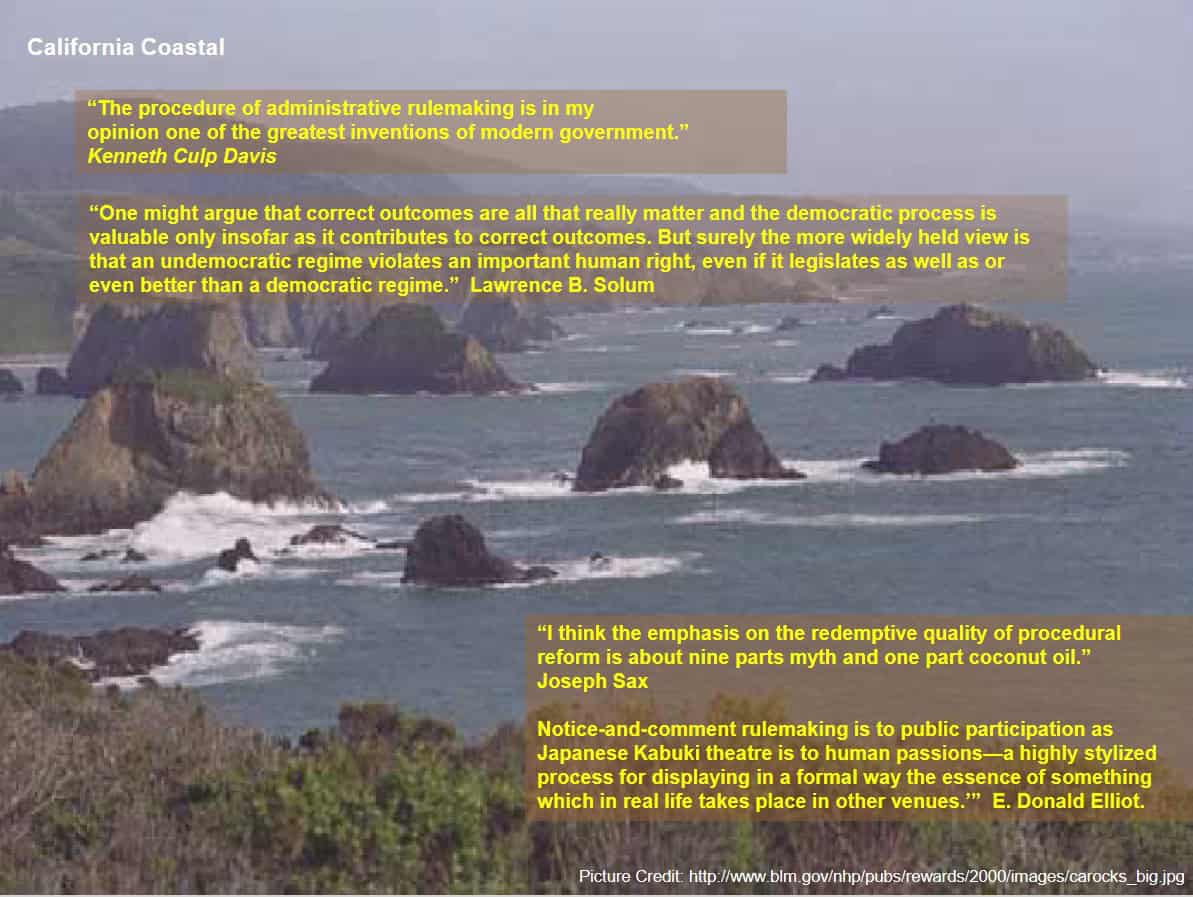
“If planning is everything, maybe it’s nothing.” Aaron Wildavsky
[Author’s note: This is a lengthy (for a blog), partisan, historical view rant on the road from NFMA “forest planning” to “adaptive governance.”]
Let’s face it, the “forest land and resource management plan” is an anachronism—an artifact of a bygone era. That era was in its heyday when the Office of Management and Budget (OMB) reigned supreme after President Richard M. Nixon consolidated rule-making and other powers in the OMB via executive order in 1970. Economics-based, comprehensive rational planning was the rage. It is no surprise that The Renewable Resources Planning Act was passed in 1974, just after Nixon consolidated power under the banner of rationally planned and carefully audited governmental process. Twenty years later Henry Mintzberg penned The Rise and Fall of Strategic Planning (1994). Mintzerberg’s classic pretty much laid a tombstone atop rational planning exercises. Or at least it should have.
The Forest Planning Era
Following passage of the National Forest Management Act of 1976 as an amendment to the Renewable Resources Planning Act of 1974, it was thought that forest program management decisions could be adequately fit into a forest plan “decision container”—that somehow each forest could develop a forest-wide plan that would integrate programs now and into the future in a such a way as to allow disclosure of environmental consequences that might flow from said decisions. Project level National Environmental Policy Act (NEPA) disclosure would disappear with proper forest planning and environmental disclosure at the forest level.
Allowance was made for FS administrative region plans, and for a national RPA Program plan. Given the upper two tiers, it was believed that decisions would be integrated vertically, and cumulative effects—according to NEPA standards—could be adequately disclosed.
It was a relatively innocent era, when viewed through the “green-eyeshaded accounting lenses” of OMB over-see-ers. The innocence collapsed relative soon in the forest arena as litigation proved that the three-level administratively-bounded review was not going to pass muster in the courts. Not only were projects not going to be shielded from NEPA review by a forest plan, there was increasing evidence that at least one level of planning/disclosure might be needed between project and forest.
An initial remedy to the seemingly endless process gridlock brought about by too many levels of planning was to eliminate regional plans. I referred to this then as the Texas two-step solution (forests/projects), since at that time the Forest Service’s National Planning Director was from Texas. But that was a solution looking for a problem, or better still a “non solution” not looking for anything but an easy way out. The problem between forest and project remained. Another problem was to be found elsewhere, framed larger than forest plans but not fitting into regional plan containers.
Spotted Owls, Roadless, and more
Much time and effort was now spent in the 1970s, 80s, 90s on above-forest policy making, brought about by actors and actions taken either against the Forest Service or from within the Forest Service responding to the Endangered Species Act of 1973. They were, “Spotted Owl Management Plans,” “The Roadless Rule,” “The Northwest Forest Plan,” and more. These decision containers were bounded as regions, not FS administrative regions but geographical regions more appropriately suited to the issues and the actors petitioning for problem resolution. Note that the policy-level decision making was largely about curtailing timbering and roading, but the Forest Service chose to name the efforts after the initiating issues, not the federal actions being considered.
Forest Planning Proves Resilient, if not usefulThe forest planning paradigm still captured much attention, but the three-level planning process swirling around the forest plan—projects/mid-scale/forest—was felt by forest planners and the Forest Service generally to be too cumbersome. Something else needed to be done. While the rest of the world was waking up to complex systems, wicked problems, and adaptive management, as was part of the Forest Service via the Northwest Forest Plan, the Forest Service via the NFMA rule was still stuck in the wonderful, if overly complex and somewhat bizarre world of capital P “Planning.” And the Forest Service was always trying to force-fit things into forest-level and project-level decision containers. But times were changing by 1990 and at least for a time, the Forest Service seemed to be ready to catch up to the rest of the world.
Adaptive Governance: Emergence in the Clinton Era
Adaptive management seems to be evolving in name to Adaptive Governance, following a path laid down early on by Kai Lee in Compass and Gyroscope: Integrating Science and Politics for the Environment (1993). For a time the Forest Service seemed inclined to follow. [Note: Today, the “adaptive governance” path seems already well-discussed, if not well traveled. That is if my “adaptive governance” Google search is an indication. But my Wikipedia search didn’t give me much. Recognizing that the only viable adaptive management for dealing with public lands management has to deal with both Kai Lee’s Adaptive management compass and his civic-engagement gyroscope. I’ll go ahead and use the term “adaptive governance” hereafter.]
In what we might call Clinton era management, Chief Michael Dombeck sought to bring about a Leopoldian awakening (see, e.g. here, here) to Forest Service thinking. That “awakening,” as per Leopold’s earlier thinking, was about adaptive governance. But the largely Republican-dominated Forest Service resisted. Chief Dombeck was never accepted by Forest Service managers since he was from the BLM and appointed by an environmentally left-leaning Clinton administration. Things didn’t get better under Chief Jack Ward Thomas, himself a huge fan of Leopold. The road from Pinchot to Leopold was not going to be an easy one. Adaptive governance thinking was soon on the chopping block along with pretty much all else from “new forestry” to “new perspectives,” etc. following the election of George W. Bush as a new Administration came to Washington.
Adaptive Governance: Bush/Cheney Backlash
The Bush/Cheney public lands legacy can be viewed as a legacy of war—war on the environment and war on anything the previous Clinton Administration had built under the rubric of “ecosystem management” (See generally Bob Keiter’s Breaking Faith with Nature: The Bush Administration and Public Land Policy). Under Mark Rey as Undersecretary of Agriculture, the Forest Service moved into its “Healthy Forests Initiative,” followed soon thereafter by the “Healthy Forest Restoration Act of 2003.” As Bob Keiter notes, the names could be viewed as cynical, as part of a well-orchestrated backlash against Clinton era reforms. To Keiter:
By using the Healthy Forests Initiative to expand the scope of NEPA categorical exclusions and to alter the ESA consultation process, the Forest Service has further enhanced its authority and reduced the potential for judicial review of its decisions, which is also what the [Aquatic Conservation Strategy] and species inventory revisions to the Northwest Forest Plan would have done. Congress has abetted this de-legalization effort by including NEPA provisions in the HFRA and the Energy Policy Act that either eliminate or reduce environmental analysis requirements for timber thinning and energy exploration projects.279 Add to this the Bush administration’s approach to its ESA responsibilities—which include an overt hostility to new listings, a rush to delist species, and contemplated revisions to the section 7 consultation process and critical habitat designation and critical habitat designation criteria—and the land management agencies could well be relieved from meaningful regulatory oversight. Related efforts to eliminate administrative appeal opportunities are plainly designed to further insulate management decisions from review. The net effect is to minimize opportunities to enforce environmental standards and procedures, and thus shield criteria—and the land management agencies could well be relieved from meaningful regulatory oversight. Related efforts to eliminate administrative appeal opportunities are plainly designed to further insulate management decisions from review. The net effect is to minimize opportunities to enforce environmental standards and procedures, and thus shield the agencies from any meaningful accountability. It is a return to an era when discretion reigned supreme. [Footnote in original]
All good things come to an end. So do all bad things. The Bush/Cheney regime and its war on the environment ended in January 2009, although effects (and federal judges) linger. [Personal aside: My friend from the early “planning days,” Dale Bosworth served as Forest Service Chief early in the Bush/Cheney Administration. I believe Dale did what he could to curb the worst of the what might have been done to the Forest Service during that era, but didn’t take my advice the be take a firm stand and be the first Chief since Gifford Pinchot to be fired for standing up against the powers that be. Had I been in his shoes I might not have taken that advice either. Who knows? But it wasn’t in Dale’s nature to work that way. I don’t find fault with Bosworth’s leadership/management during that era.]
Adaptive Governance: Obama’s ‘Audacity of Hope’
Unfortunately for Leopoldian dreamers, incoming President Barrack Obama’s audacious plans have not yet been focused on matters environmental, other than green energy. Nor will they likely anytime soon, even if Obama or anyone in his Administration were prone to do so—which itself is in question. Obama is too distracted with two wars, emergent unrest in the Mideast and Middle America following Tea Party elections in statehouses and the US Congress. Not to mention continued after-shocks from the near-disaster of the financial meltdown that arrived coincidentally (or not) right as Obama was entering the White House.
Obama cut his political teeth on community organizing, and that is in a sense Kai Lee’s gyroscope to accompany his adaptive management compass. So we can at least hope for endorsement from Obama if planning is replaced with adaptive governance. Whether or not it will be a good thing depends largely on whether or not untoward devolution happens—or is perceived to likely happen—under adaptive governance schemes. Time will tell. But I get ahead of our story. The Forest Service hasn’t yet embraced adaptive governance, although I hear they are flirting with it. Instead they are still wedded to capital P “Planning.” As Andy Stahl noted, the recent Draft NFMA “planning rule” (pdf) (as the Forest Service likes to call it), stages up a rational planning exercise. The difference is that this time it is driven by ecological rationality instead of the earlier economic rationality from the OMB era.
Adaptive Governance: Absent in the NFMA Draft Planning Rule
I suspect it was because the Bush/Cheney era NFMA rule was thrown away by the courts, but for whatever reason the Obama Administration chose to rewrite the “NFMA rule.” There has been a flurry of commentary on this blog and elsewhere about the rule and associated planning. But does anyone really care about this type planning anymore? What decisions are really contained by a forest-level plan? Despite the language of the draft rule, I find no “ecological resilience” decisions, neither “ecological or social sustainability” decisions, nor any “species viability” decisions, nor … that can be contained in a forest-level plan. All such considerations will well-up at scales different from forest boundaries.
As I’ve argued before, these are wicked problems. Wicked problems are not amenable to rational planning resolutions. Part of the “wicked problem” problem is that they are shape-shifters, they vary in problem identification and resolution across both time and space. They just won’t stand still, and will not be force-fit into predetermined “decision containers.”
In addressing wicked problems, I believe that scale-dependent futuring, and/or puzzle solving, is in order alongside scale-dependent assessments and monitoring. We ought to add in scale-dependent standard setting. They all fit under a header “puzzle solving.” Where scale-dependent is really the stuff of framing decisions/actions according to a “Garbage Can Model” wherein issues, actors, and arenas self-organize across the landscape into various and sundry decision containers. We all need to think hard about wicked problems and, e.g. Cohen, March, and Olsen’s garbage can decision model. Here’s a pdf of CMO’s 1972 article: “A Garbage Can Theory of Organizational Choice.”
See too Pritchard and Sanderson’s chapter in Panarchy: Understanding Transformations in Human and Natural Systems (2002), “The Dynamics of Political Discourse in Seeking Sustainability.” After setting stage for adaptive governance, complete with “wicked problem identification” and “garbage can” resolution mechanisms, Pritchard and Sanderson conclude:
[Testing hypotheses and applying lessons learned] to the thorny puzzles of environmental management and governance are [noble] goals. The greatest promise lies in addressing political issues directly, rather than in avoiding or submerging them. The fondest hope might be that individuals, communities, and formal organizations engage the spirit of adaptation and experimentation, by allowing a set of contingent ideas to shape “the gamble” of democratic resource management, and citizen experts to report on the results. Of course, for such a profoundly disorganized and multiscale approach to thrive, government, market, and citizen must share a common vision—that all must address these puzzles in order that they might be engaged and worked on—not solved forever; that “expertise,” popular voice, and power are separable, and none holds the dice [from a “floating crap game” model of politics] for more than a pass.
A Few Questions Linger
Is an ecologically framed rational planning rule what we need to resolve controversy?
Or is it time to embrace adaptive management, even adaptive governance in an attempt to tame wicked problems? Yes, I know that the preamble to the Draft NFMA rule claims that forest planning will be driven by adaptive management. But, really? Read the rule and explain to me how the draft rule stages for more than rational planning.
———–
Related:
The Forest Service as a Learning Challenged Organization, Iverson, 1999
US Forest Service Deeply Flawed Planning Culture, Iverson, 2004






